2018 Infiniti Q50 Red Sport 400 AWD
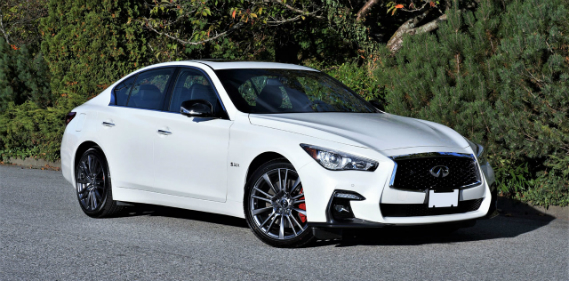
Moving Infiniti a solid step up the premium D-segment desirability ladder
Sometimes subtle changes make all the difference. Not that the outgoing Q50 was unattractive. In fact it was just the opposite. I’d say it was one of the more aesthetically pleasing cars in its class, but this refreshed 2018 model adds just the right amount of spice to styling that was starting to lose its savor. Even the best designs do, and the old Q50 wasn’t about to wear out its welcome.
The outgoing Q50 first arrived in 2013 as a 2014 model. Four years is hardly long-lived for a premium model, not even coming close to the brand’s QX50, which when replaced next year will have been soldiering along with only minor updates for 11 years, but changes to the 2018 Q50 weren’t anywhere near as dramatic.
The upgrades include a modestly reworked version of Infiniti’s trademark double-arch grille that now includes more texture within its wavy mesh-patterned insert, while more muscular character lines now follow the upper outside corners of that grille across each side of the hood. These changes were joined by revised headlamps, featuring standard LEDs for more cat’s eye-like illumination, and redesigned LED taillights at the car’s polar end. While all these updates help modernize the Q50’s look, the new model’s most noticeable changes were saved for its lower front fascia, which now more clearly depicts the trim line, or rather “grade structure” being shown.
For 2018, the Q50 will be available in Pure, Luxe, Sport and as-tested Red Sport 400 trims. The latter two “grades” will be familiar to those who follow Infiniti’s products, although Infiniti has never used Pure and Luxe before. Let’s be first to congratulate them for not including Limited or Platinum in their naming scheme, two of the most overused trim designations in the industry, not to mention kudos for dropping the similarly derivative Premium designation, after which we should give the brand a collective nod of approval for visually separating each trim line to benefit those paying more to move up into a higher-end model.
Of note, Sport grade offers performance-focused exterior styling, while even sportier visual upgrades enhance the Red Sport 400. Visuals specific to the two top-line grades include a more sharply creased front bumper and wider, lower air intakes, the corner vents edged in glossy black that’s particularly easy to pick out in my tester’s Pure White paint, while the rear bumper gets a bolder black diffuser embedded at center, with a stainless steel exhaust tip at each corner. The Red Sport 400 takes things up a notch with unique tailpipes flanking a glossy dark painted and body-color diffuser, while the side mirror caps also get a gloss black treatment, plus a unique set of 19-inch alloys framing red-painted brake calipers to finish off the track-ready look.

Inside, Infiniti added what appears to be a higher-grade of genuine metal atop the center console, door panels and elsewhere, while the seat bolsters get some gorgeous quilting and red stitching, giving the car a rich ambience. What’s more, every Q50 covers the instrument panel with double-stitched padded leatherette, while more traditional luxury-oriented models get naturally authentic hardwood inlays.
The patterned aluminum inlays on my Red Sport 400 tester also bling up the Sport model’s interior, as do matte dark-chromed accents plus a black cloth headliner and pillars, while the new sport steering wheel is ideally formed for performance driving, allowing an easy reach to the solid magnesium shift paddles in behind. The new leather-wrapped shift knob has been ergonomically designed as well, enhanced with double-stitched seams, new chrome trim, and an Infiniti logo on top.
Infiniti didn’t hold back with the red stitching effect throughout the rest of the Red Sport 400’s cabin either, but at least they didn’t go so far as to brighten up the stitching within each and every diamond-quilted crevice of its Bentley-esque seats’ side inserts, the result looking rich yet nicely restrained. As importantly those seats include a more comfortable “spinal support” design that can be felt initially when sitting down and more so after a long stint behind the wheel. The lower cushions of both front seats extend as well, while the driver’s torso bolsters can be powered in and out for additional lateral support. Lastly, the new Red Sport 400 gets unique dark chromed primary instrument bezels, although those fully infused into the digital age might feel the analog gauges are a bit of a throwback when others in the class are offering fully configurable color TFT instruments in their top-line trims.
Despite the classic dual-dial gauge cluster, Infiniti might potentially pull some buyers over from its German competitors when it comes to center stack infotainment because it continues to use a duo of more familiar, tablet-style touch-capacitive interfaces instead of a rotating controller, button and/or touchpad design. These vertically stacked displays allow the use of multiple functions simultaneously, such as navigation mapping on the top eight-inch screen and audio control for the bottom seven-inch one. Infiniti’s appropriately named InTouch infotainment system also lets its various drivers customize the car’s inner environment by storing detailed personal information for multiple users, such as memory seating and mirror positions, identifiable via individual proximity-sensing I-keys.
Also new for 2018, my Q50 was equipped with an available 16-speaker Bose “Performance Series” audio system featuring advanced staging signal processing capable of “a precise, rich and nuanced acoustic experience,” said Infiniti in their initial press release, plus CenterPoint 2.0 surround-sound. I have to agree with Infiniti, as the sound quality is superb.
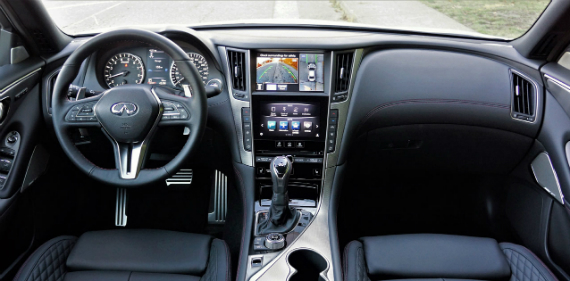
Possibly the biggest 2018 Q50 news is its available suite of ProPILOT advanced driver-assistance systems, which include Active Lane Control (camera-sighted autonomous driving capability above 45 mph), Intelligent Cruise Control, Distance Control Assist, Backup Collision Intervention, Blind Spot Warning and Intervention, Lane Departure Warning and Prevention, Forward Emergency Braking, Predictive Forward Collision Warning, and last but hardly least, Infiniti’s exclusive Direct Adaptive Steering.
This is Infiniti’s second-generation Direct Adaptive Steering introduced in 2016 (the first version was launched in 2013), both of which are steer-by-wire systems that mostly do away with mechanically linked parts, and have been fairly well received by owners and auto pundits alike. Infiniti considers its Direct Adaptive Steering a “building block on the way to achieving fully-autonomous driving,” and it truly is a bit of tomorrow’s technology today. Along with reasonably realistic feel and ultra-quick responsiveness, Direct Adaptive Steering makes it easier to add unique driving modes for comfort or sport applications, the Q50’s Drive Mode Selector letting its driver modulate steering, suspension and drivetrain settings that include Personal, Standard (default), Snow, Eco, Sport and Sport+ modes. Those rightly concerned about no longer having a steering column connected to the turning wheels can take some confidence in knowing Infiniti has logged more than 625,000 miles of tests on the second-gen Direct Adaptive Steering system alone.
The 2018 Q50’s three powertrains (one of which comes in two states of tune) are all carryover, although this shouldn’t come as a surprise as they were just updated for the 2016 model year. Included is the base 2.0t, a Mercedes-sourced 208 horsepower 2.0-liter four-cylinder featuring 258 lb-ft of torque that gets mated to Infiniti’s in-house seven-speed automatic and standard rear- or optional all-wheel drive, the transmission standard with the other two conventional engine choices and AWD available across the line.
Of note, the Q50’s AWD system has long been lauded for its rear-wheel biased response and feel in high-grip conditions, which aids performance, while the quick-shifting seven-speed auto remains one of the most advanced of its type in the industry due to dual transmission fluid coolers, Adaptive Shift Control (ASC) boasting an adaptive learning algorithm that senses a driver’s style and automatically adjusts shifting accordingly (upgraded with navigation-synchronized capability in upper trims), as well as a manual shift mode that makes you drive and sound like a pro thanks to Downshift Rev Matching (DRM).
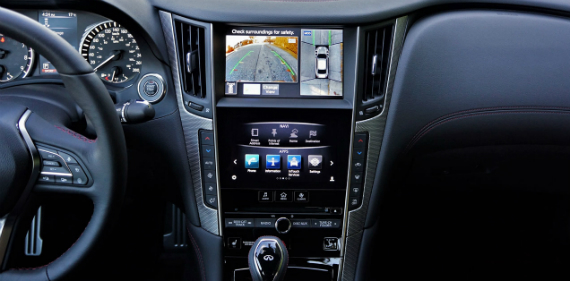
The performance-oriented 3.0t models include two different versions of Infiniti’s exclusive new in-house VR family of 3.0-liter twin-turbo V6s, which just like the old VQ V6 is once again a 2017 Ward’s 10 Best Engines winner. The less formidable powerplant is good for 300 horsepower and 295 lb-ft of torque, which will be more than adequate for most, but the top-line Red Sport 400 being reviewed here pushes out a shocking 400 horsepower and 350 lb-ft of torque.
Before I delve into how that powertrain feels when hooked up to the refreshed Q50, I need to tell you that Infiniti’s high-energy Direct Response Hybrid powertrain continues into 2018 too. This power unit consists of the brand’s old 3.5-liter V6, plus a 50-kW electric motor, and a compact laminated lithium-ion battery. The combination makes a net 360 horsepower due to the internal combustion engine’s 302 horsepower and electric motor’s 67 horsepower (hybrid net output never adds up exactly), plus a non-advertised sum of torque, although the ICE’s 258 lb-ft and electric motor’s 213 lb-ft makes for a potent mixture.
The Q50 Hybrid is good for an EPA claimed 27 mpg city, 32 highway and 29 combined in RWD guise and 26, 30 and 28 respectively when mated to AWD, which makes it quite thrifty considering the performance on tap, while the 2017 Q50 2.0t is estimated to achieve 23 mpg city, 30 highway and 25 combined in RWD trim or 22, 28 and 24 with AWD, thanks partially to fuel-saving stop/start technology. Additionally, the mid-range 3.0t achieves a rating of 20 city, 29 highway and 23 combined in RWD trim or 19, 27 and 22 with AWD, while the top-tier Red Sport 400 earned an estimated 20 city, 26 highway and 22 combined in RWD or 19, 26 and 22 with AWD.
Of note, Q50s fitted with the larger engine will get Infiniti’s refined “Rack Electronic Power Steering” as standard, which can also be modulated via the aforementioned Drive Mode Selector, while 2.0-liter Q50 models are equipped with more conventional vehicle speed-sensitive hydraulic electronic rack-and-pinion power steering.
While every Q50 incorporates a fully independent aluminum-intensive suspension combining a front double-wishbone design and a rear multi-link setup, plus stabilizer bars at both ends, Sport and Red Sport 400 trims go a step further by integrating a Dynamic Digital Suspension, capable of a more dramatic swing between comfort on one end and performance at the other. This allows you to firm up the electronically adjustable dampers via the previously noted Sport or Sport+ modes when pushing hard, at which point the suspension constantly adjusts for optimal handling and ride quality.
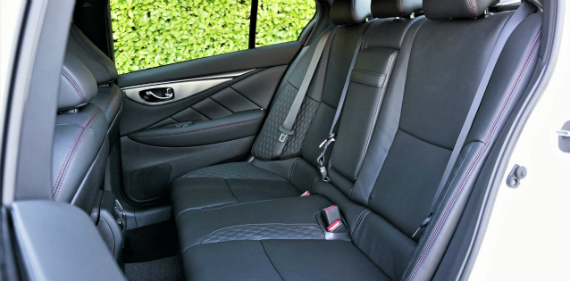
The Q50 Red Sport 400 really did an admirable job both smoothing out rough patches of pavement and staying glued to changing road surfaces, even when flung around some of the more challenging off-camber, bump, dip and crumbling tarmac riddled corners of my local “test track.” It’s a good thing too, especially when factoring in how quickly the car turns in, its steering response unfathomably fast, and more so how immediately it gets up to target speed, and before you know it, accelerates beyond posted limits, its upsized four-piston caliper enhanced front brakes and two-piston rears more than adequate for scrubbing off that speed when called upon.
While all this might make the Red Sport 400 come across like some sort of M3 fighter, don’t be confused by its performance numbers. Where the ultra-hot BMW is like driving a racecar on the street, the Q50 Red Sport 400 is brilliantly capable yet more about smooth, fast refinement. This transcends into a cabin that’s less about creating a race replica experience and more about resplendent luxury, its stitched leather-like dash-top, instrument panel, lower console sides, and door panels going above and beyond most peers when it comes to soft-touch pampering, despite not finishing its lower dash (under the knees) and door panels in pliable plastics, albeit once again the glove box lid gets a dose of the good stuff for a nice upscale feel. Likewise, all of the switchgear is superb.
The Q50’s base Pure grade includes a lot of upscale goodies for its ultra-competitive $34,200 base price, such as that advanced seven-speed auto noted earlier, plus 17-inch alloys, LED headlights, LED fog lamps, LED taillights, proximity keyless entry, pushbutton ignition, rain-sensing wipers, heated side mirrors, eight-way powered front seats, dual-zone auto climate control, InTouch dual-display infotainment, a backup camera, voice recognition, SMS text and email reading capability, satellite radio, two USB ports, 60/40 split-folding rear seats with a flip-down center armrest and handy center pass-through, Scratch Shield exterior paint, and much more, while $36,550 Luxe trim adds 18-inch alloys, an auto-dimming rearview mirror, a garage door opener, a powered moonroof, genuine maple inlays, etcetera.
Sport trim, at $40,650, provides all the styling and performance changes already noted, plus staggered 19-inch alloys, the aforementioned sport seats with thigh extenders and powered bolsters, leather upholstery, Kacchu aluminum inlays, SiriusXM real-time traffic info, and more, whereas the $51,000 Red Sport 400 adds its unique styling and performance upgrades as well as aluminum pedals, navigation, lane guidance, 3D building graphics, front and rear parking sensors, a 360-degree Around View Monitor with Moving Object Detection, cross-traffic alert with backup collision intervention, blindspot monitoring, predictive forward collision warning (that can see two cars ahead), and forward emergency autonomous braking, quilted semi-aniline leather upholstery, a heated steering wheel, heatable front seats, the aforementioned dark metal trim, and more.
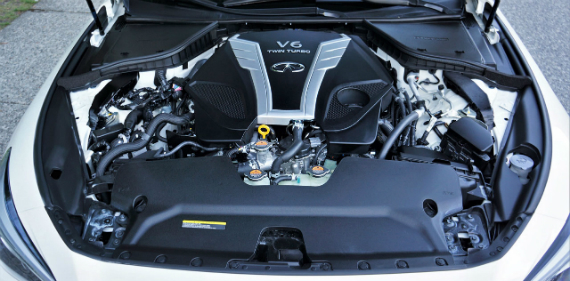
Many of the Red Sport 400’s extra features can be had through various options packages, while my tester also featured two upgrade groups of its own, starting with a $2,650 Sensory package that adds auto-dimming side mirrors with reverse tilt-down, a powered steering column, driver’s memory for the seat, side mirrors and steering wheel, advanced climate control with auto-recirculation, plasmacluster air purification and grape polyphenol filtration, 16-speaker Bose audio, and more, while the $2,700 ProActive packaged added Direct Adaptive Steering, auto-leveling and adaptive cornering headlamps with auto high beams, adaptive cruise control with distance control assist, lane departure warning, lane departure prevention with active lane control, blindspot intervention, front pre-crash seatbelts, and Infiniti’s Eco Pedal that forcefully pushes back on the throttle when it believes you’re being too aggressive, and by so doing causes those who might otherwise use Eco mode to cease and desist—if you can’t tell I don’t like it.
I do like the car, however, a great deal. From its beautifully sculpted outward design and superbly crafted, wonderfully accommodating interior, to its extremely well balanced comfort and performance dynamics, the 2018 Q50 moves Infiniti a solid step up the premium D-segment desirability ladder, especially in top-tier Red Sport 400 trim. That it can be had for such reasonable value is a significant bonus.
*Story credits: Trevor Hofmann, American Auto Press Photo credits: Karen Tuggay, American Auto Press Copyright: American Auto Press *
